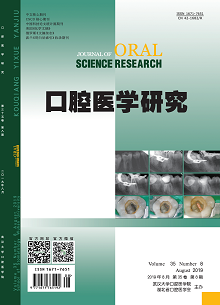|
|
Effect of Three Resin Adhesives on Color Stability of IPS E.Max Press Cast Porcelain and Zirconia All-ceramic Restorations
YUAN Shuo, CHEN Zhiyu, MA Xiaoping
2019, 35(8):
798-801.
DOI: 10.13701/j.cnki.kqyxyj.2019.08.018
Objective: To investigate the effect of three resin adhesives on the color stability of IPS E.Max press cast porcelain and zirconia all-ceramic restorations. Methods: A total of 45 zirconia all-ceramic specimens and 45 cast-ceramic specimens were prepared and randomly divided into A-F groups, with 15 specimens in each group. Zirconia all-ceramic specimens in groups A, B, and C were bonded with FujiCEM, RelyX Unicem, and RelyX Veneer resins, respectively. Cast-ceramic specimens in group D, E, and F were bonded with FujiCEM, RelyX Unicem, and RelyX Veneer resins, respectively. Shadepilot digital colorimeter was used to measure the optical value (L, a, b) before (T0), 1 month (T1), 3 months (T2), 6 months (T3), and 9 months (T4) after immersion, respectively. The color difference (△E) was calculated. Results: At T0-T4 time points, there were significant differences in L*, a*, b*, and △E values between group A, B, C and D, E, F (P<0.05). At T1-T4 time points, the value of △E in group A was higher than that in group B and C (P<0.05), and the value of △E in group D was higher than that in group E and F (P<0.05). During the nine-month experiment, no discernible color changes were observed in group A, B, C, E and F. In group D, discernible color changes were observed at T3 (6 months) time point and further increased at T4 (9 months) time point. Conclusion: Compared with Relyx Unicem and Relyx, Fujicem has the greatest influence on color stability, especially on the color stability of cast-ceramic.
References |
Related Articles |
Metrics
|

